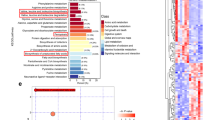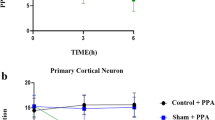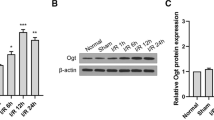Abstract
Humans exhibit a rich intestinal microbiome that contain high levels of bacteria capable of producing 3-oxo-lithocholic acid (3-oxoLCA) and other secondary bile acids (BAs). The molecular mechanism mediating the role of 3-oxoLCA in cerebral ischemia-reperfusion (I/R) injury remains unclear. We investigated the role of 3-oxoLCA in a rat cerebral I/R injury model. We found that the concentrations of 3-oxoLCA within the cerebrospinal fluid were increased following I/R. In the in vitro oxygen-glucose deprivation (OGD) model, the levels of intraneuronal 3-oxoLCA was elevated following OGD insult. We showed that the increase of membrane ASBT (apical sodium-dependent bile acid transporter) contributed to OGD-induced elevation of intraneuronal 3-oxoLCA. Increasing intraneuronal 3-oxoLCA promoted ischemia-induced neuronal death, whereas reducing 3-oxoLCA levels were neuroprotective. Our results revealed that PLOD2 (procollagen-lysine, 2-oxoglutarate 5-dioxygenases 2) functioned upstream of PTEN (the phosphatase and tensin homolog deleted on chromosome 10) and downstream of 3-oxoLCA to promote OGD-induced neuronal injury. We further demonstrated that direct-current stimulation (DCS) decreased the levels of intraneuronal 3-oxoLCA and membrane ASBT in OGD-insulted neurons, while bilateral transcranial DCS (tDCS) reduced brain infarct volume following I/R by inhibiting ASBT. Together, these data suggest that increased expression of ASBT promotes neuronal death via 3-oxoLCA-PLOD2-PTEN signaling pathway. Importantly, bilateral tDCS suppresses ischemia-induced increase of ASBT, thereby conferring neuroprotection after cerebral I/R injury.








Similar content being viewed by others
Data Availability
The data that support the findings of this study are available from the corresponding author upon reasonable request. Some data may not be made available because of privacy or ethical restrictions.
References
Hang S, Paik D, Yao L, Kim E, Trinath J, Lu J, Ha S, Nelson BN, Kelly SP, Wu L, Zheng Y, Longman RS, Rastinejad F, Devlin AS, Krout MR, Fischbach MA, Littman DR, Huh JR (2019) Bile acid metabolites control T(H)17 and T(reg) cell differentiation. Nature 576(7785):143–148. https://doi.org/10.1038/s41586-019-1785-z
Gafar AA, Draz HM, Goldberg AA, Bashandy MA, Bakry S, Khalifa MA, AbuShair W, Titorenko VI, Sanderson JT (2016) Lithocholic acid induces endoplasmic reticulum stress, autophagy and mitochondrial dysfunction in human prostate cancer cells. PeerJ 4:e2445. https://doi.org/10.7717/peerj.2445
Hang S, Paik D, Yao L, Kim E, Trinath J, Lu J, Ha S, Nelson BN, Kelly SP, Wu L, Zheng Y, Longman RS, Rastinejad F, Devlin AS, Krout MR, Fischbach MA, Littman DR, Huh JR (2019) Bile acid metabolites control TH17 and Treg cell differentiation. Nature 576(7785):143–148. https://doi.org/10.1038/s41586-019-1785-z
Song X, Sun X, Oh SF, Wu M, Zhang Y, Zheng W, Geva-Zatorsky N, Jupp R, Mathis D, Benoist C, Kasper DL (2020) Microbial bile acid metabolites modulate gut RORgamma(+) regulatory T cell homeostasis. Nature 577(7790):410–415. https://doi.org/10.1038/s41586-019-1865-0
Quinn M, McMillin M, Galindo C, Frampton G, Pae HY, DeMorrow S (2014) Bile acids permeabilize the blood brain barrier after bile duct ligation in rats via Rac1-dependent mechanisms. Dig Liver Dis 46(6):527–534. https://doi.org/10.1016/j.dld.2014.01.159
Thibaut MM, Bindels LB (2022) Crosstalk between bile acid-activated receptors and microbiome in entero-hepatic inflammation. Trends Mol Med 28(3):223–236. https://doi.org/10.1016/j.molmed.2021.12.006
Nizamutdinov D, DeMorrow S, McMillin M, Kain J, Mukherjee S, Zeitouni S, Frampton G, Bricker PC, Hurst J, Shapiro LA (2017) Hepatic alterations are accompanied by changes to bile acid transporter-expressing neurons in the hypothalamus after traumatic brain injury. Sci Rep 7:40112. https://doi.org/10.1038/srep40112
Alpini G, Ueno Y, Glaser SS, Marzioni M, Phinizy JL, Francis H, Lesage G (2001) Bile acid feeding increased proliferative activity and apical bile acid transporter expression in both small and large rat cholangiocytes. Hepatology 34(5):868–876. https://doi.org/10.1053/jhep.2001.28884
van der Slot AJ, Zuurmond AM, Bardoel AF, Wijmenga C, Pruijs HE, Sillence DO, Brinckmann J, Abraham DJ, Black CM, Verzijl N, DeGroot J, Hanemaaijer R, TeKoppele JM, Huizinga TW, Bank RA (2003) Identification of PLOD2 as telopeptide lysyl hydroxylase, an important enzyme in fibrosis. J Biol Chem 278(42):40967–40972. https://doi.org/10.1074/jbc.M307380200
Yamauchi M, Sricholpech M (2012) Lysine post-translational modifications of collagen. Essays Biochem 52:113–133. https://doi.org/10.1042/bse0520113
Song Y, Zheng S, Wang J, Long H, Fang L, Wang G, Li Z, Que T, Liu Y, Li Y, Zhang X, Fang W, Qi S (2017) Hypoxia-induced PLOD2 promotes proliferation, migration and invasion via PI3K/Akt signaling in glioma. Oncotarget 8(26):41947–41962. https://doi.org/10.18632/oncotarget.16710
Woods AJ, Antal A, Bikson M, Boggio PS, Brunoni AR, Celnik P, Cohen LG, Fregni F, Herrmann CS, Kappenman ES, Knotkova H, Liebetanz D, Miniussi C, Miranda PC, Paulus W, Priori A, Reato D, Stagg C, Wenderoth N, Nitsche MA (2016) A technical guide to tDCS, and related non-invasive brain stimulation tools. Clin Neurophysiol 127(2):1031–1048. https://doi.org/10.1016/j.clinph.2015.11.012
Zhang KY, Rui G, Zhang JP, Guo L, An GZ, Lin JJ, He W, Ding GR (2020) Cathodal tDCS exerts neuroprotective effect in rat brain after acute ischemic stroke. BMC Neurosci 21(1):21. https://doi.org/10.1186/s12868-020-00570-8
Peruzzotti-Jametti L, Cambiaghi M, Bacigaluppi M, Gallizioli M, Gaude E, Mari S, Sandrone S, Cursi M, Teneud L, Comi G, Musco G, Martino G, Leocani L (2013) Safety and efficacy of transcranial direct current stimulation in acute experimental ischemic stroke. Stroke 44(11):3166–3174. https://doi.org/10.1161/STROKEAHA.113.001687
Nitsche MA, Fricke K, Henschke U, Schlitterlau A, Liebetanz D, Lang N, Henning S, Tergau F, Paulus W (2003) Pharmacological modulation of cortical excitability shifts induced by transcranial direct current stimulation in humans. J Physiol 553(Pt 1):293–301. https://doi.org/10.1113/jphysiol.2003.049916
Monai H, Ohkura M, Tanaka M, Oe Y, Konno A, Hirai H, Mikoshiba K, Itohara S, Nakai J, Iwai Y, Hirase H (2016) Calcium imaging reveals glial involvement in transcranial direct current stimulation-induced plasticity in mouse brain. Nat Commun 7:11100. https://doi.org/10.1038/ncomms11100
Braun R, Klein R, Walter HL, Ohren M, Freudenmacher L, Getachew K, Ladwig A, Luelling J, Neumaier B, Endepols H, Graf R, Hoehn M, Fink GR, Schroeter M, Rueger MA (2016) Transcranial direct current stimulation accelerates recovery of function, induces neurogenesis and recruits oligodendrocyte precursors in a rat model of stroke. Exp Neurol 279:127–136. https://doi.org/10.1016/j.expneurol.2016.02.018
Pikhovych A, Stolberg NP, Jessica Flitsch L, Walter HL, Graf R, Fink GR, Schroeter M, Rueger MA (2016) Transcranial direct current stimulation modulates neurogenesis and microglia activation in the mouse brain. Stem Cells Int 2016:2715196. https://doi.org/10.1155/2016/2715196
Li L, El-Hayek YH, Liu B, Chen Y, Gomez E, Wu X, Ning K, Li L, Chang N, Zhang L, Wang Z, Hu X, Wan Q (2008) Direct-current electrical field guides neuronal stem/progenitor cell migration. Stem Cells 26(8):2193–2200. https://doi.org/10.1634/stemcells.2007-1022
McGrath JC, Lilley E (2015) Implementing guidelines on reporting research using animals (ARRIVE etc.): new requirements for publication in BJP. Br J Pharmacol 172(13):3189–3193. https://doi.org/10.1111/bph.12955
Chen J, Hu R, Liao H, Zhang Y, Lei R, Zhang Z, Zhuang Y, Wan Y, Jin P, Feng H, Wan Q (2017) A non-ionotropic activity of NMDA receptors contributes to glycine-induced neuroprotection in cerebral ischemia-reperfusion injury. Sci Rep 7(1):3575. https://doi.org/10.1038/s41598-017-03909-0
Kong X, Hu W, Cui Y, Gao J, Yao X, Ren J, Lin T, Sun J, Gao Y, Li X, Wang H, Li H, Che F, Wan Q (2022) Transcranial direct-current stimulation regulates MCT1-PPA-PTEN-LONP1 signaling to confer neuroprotection after rat cerebral ischemia-reperfusion injury. Mol Neurobiol 59(12):7423–7438. https://doi.org/10.1007/s12035-022-03051-7
Xu X, Cui Y, Li C, Wang Y, Cheng J, Chen S, Sun J, Ren J, Yao X, Gao J, Huang X, Wan Q, Wang Q (2021) SETD3 downregulation mediates PTEN upregulation-induced ischemic neuronal death through suppression of actin polymerization and mitochondrial function. Mol Neurobiol 58(10):4906–4920. https://doi.org/10.1007/s12035-021-02459-x
Liu B, Liao M, Mielke JG, Ning K, Chen Y, Li L, El-Hayek YH, Gomez E, Zukin RS, Fehlings MG, Wan Q (2006) Ischemic insults direct glutamate receptor subunit 2-lacking AMPA receptors to synaptic sites. J Neurosci 26(20):5309–5319. https://doi.org/10.1523/JNEUROSCI.0567-06.2006
Cui Y, Zhang Z, Zhou X, Zhao Z, Zhao R, Xu X, Kong X, Ren J, Yao X, Wen Q, Guo F, Gao S, Sun J, Wan Q (2021) Microglia and macrophage exhibit attenuated inflammatory response and ferroptosis resistance after RSL3 stimulation via increasing Nrf2 expression. J Neuroinflammation 18(1):249. https://doi.org/10.1186/s12974-021-02231-x
Cui Y, Zhang Y, Zhao X, Shao L, Liu G, Sun C, Xu R, Zhang Z (2021) ACSL4 exacerbates ischemic stroke by promoting ferroptosis-induced brain injury and neuroinflammation. Brain Behav Immun 93:312–321. https://doi.org/10.1016/j.bbi.2021.01.003
Zheng M, Liao M, Cui T, Tian H, Fan DS, Wan Q (2012) Regulation of nuclear TDP-43 by NR2A-containing NMDA receptors and PTEN. J Cell Sci 125(Pt 6):1556–1567. https://doi.org/10.1242/jcs.095729
Shi Y, Xiong J, Sun D, Liu W, Wei F, Ma S, Lin R (2015) Simultaneous quantification of the major bile acids in artificial Calculus bovis by high-performance liquid chromatography with precolumn derivatization and its application in quality control. J Sep Sci 38(16):2753–2762. https://doi.org/10.1002/jssc.201500139
Guo JM, Liu AJ, Zang P, Dong WZ, Ying L, Wang W, Xu P, Song XR, Cai J, Zhang SQ, Duan JL, Mehta JL, Su DF (2013) ALDH2 protects against stroke by clearing 4-HNE. Cell Res 23(7):915–930. https://doi.org/10.1038/cr.2013.69
Liebetanz D, Koch R, Mayenfels S, Konig F, Paulus W, Nitsche MA (2009) Safety limits of cathodal transcranial direct current stimulation in rats. Clin Neurophysiol 120(6):1161–1167. https://doi.org/10.1016/j.clinph.2009.01.022
Charan J, Kantharia ND (2013) How to calculate sample size in animal studies? J Pharmacol Pharmacother 4(4):303–306. https://doi.org/10.4103/0976-500X.119726
Wu Y, Aquino CJ, Cowan DJ, Anderson DL, Ambroso JL, Bishop MJ, Boros EE, Chen L, Cunningham A, Dobbins RL, Feldman PL, Harston LT, Kaldor IW, Klein R, Liang X, McIntyre MS, Merrill CL, Patterson KM, Prescott JS et al (2013) Discovery of a highly potent, nonabsorbable apical sodium-dependent bile acid transporter inhibitor (GSK2330672) for treatment of type 2 diabetes. J Med Chem 56(12):5094–5114. https://doi.org/10.1021/jm400459m
Tough IR, Schwartz TW, Cox HM (2020) Synthetic G protein-coupled bile acid receptor agonists and bile acids act via basolateral receptors in ileal and colonic mucosa. Neurogastroenterol Motil 32(12):e13943. https://doi.org/10.1111/nmo.13943
Zuurmond AM, van der Slot-Verhoeven AJ, van Dura EA, De Groot J, Bank RA (2005) Minoxidil exerts different inhibitory effects on gene expression of lysyl hydroxylase 1, 2, and 3: implications for collagen cross-linking and treatment of fibrosis. Matrix Biol 24(4):261–270. https://doi.org/10.1016/j.matbio.2005.04.002
Arlia-Ciommo A, Piano A, Svistkova V, Mohtashami S, Titorenko VI (2014) Mechanisms underlying the anti-aging and anti-tumor effects of lithocholic bile acid. Int J Mol Sci 15(9):16522–16543. https://doi.org/10.3390/ijms150916522
Fiorucci S, Biagioli M, Zampella A, Distrutti E (2018) Bile acids activated receptors regulate innate immunity. Front Immunol 9:1853. https://doi.org/10.3389/fimmu.2018.01853
Weinman SA, Carruth MW, Dawson PA (1998) Bile acid uptake via the human apical sodium-bile acid cotransporter is electrogenic. J Biol Chem 273(52):34691–34695. https://doi.org/10.1074/jbc.273.52.34691
Gilkes DM, Bajpai S, Wong CC, Chaturvedi P, Hubbi ME, Wirtz D, Semenza GL (2013) Procollagen lysyl hydroxylase 2 is essential for hypoxia-induced breast cancer metastasis. Mol Cancer Res 11(5):456–466. https://doi.org/10.1158/1541-7786.MCR-12-0629
Jones CE, Sharick JT, Colbert SE, Shukla VC, Zent JM, Ostrowski MC, Ghadiali SN, Sizemore ST, Leight JL (2021) Pten regulates collagen fibrillogenesis by fibroblasts through SPARC. PLoS One 16(2):e0245653. https://doi.org/10.1371/journal.pone.0245653
Eisinger-Mathason TS, Zhang M, Qiu Q, Skuli N, Nakazawa MS, Karakasheva T, Mucaj V, Shay JE, Stangenberg L, Sadri N, Pure E, Yoon SS, Kirsch DG, Simon MC (2013) Hypoxia-dependent modification of collagen networks promotes sarcoma metastasis. Cancer Discov 3(10):1190–1205. https://doi.org/10.1158/2159-8290.CD-13-0118
Buffie CG, Bucci V, Stein RR, McKenney PT, Ling L, Gobourne A, No D, Liu H, Kinnebrew M, Viale A, Littmann E, van den Brink MR, Jenq RR, Taur Y, Sander C, Cross JR, Toussaint NC, Xavier JB, Pamer EG (2015) Precision microbiome reconstitution restores bile acid mediated resistance to Clostridium difficile. Nature 517(7533):205–208. https://doi.org/10.1038/nature13828
Thanissery R, Winston JA, Theriot CM (2017) Inhibition of spore germination, growth, and toxin activity of clinically relevant C. difficile strains by gut microbiota derived secondary bile acids. Anaerobe 45:86–100. https://doi.org/10.1016/j.anaerobe.2017.03.004
Schmidt S, Moncada M, Burger S, Geyer J (2015) Expression, sorting and transport studies for the orphan carrier SLC10A4 in neuronal and non-neuronal cell lines and in Xenopus laevis oocytes. BMC Neurosci 16:35. https://doi.org/10.1186/s12868-015-0174-2
Smith TM, Lee MK, Szabo CI, Jerome N, McEuen M, Taylor M, Hood L, King MC (1996) Complete genomic sequence and analysis of 117 kb of human DNA containing the gene BRCA1. Genome Res 6(11):1029–1049. https://doi.org/10.1101/gr.6.11.1029
Sato Y, Atarashi K, Plichta DR, Arai Y, Sasajima S, Kearney SM, Suda W, Takeshita K, Sasaki T, Okamoto S, Skelly AN, Okamura Y, Vlamakis H, Li Y, Tanoue T, Takei H, Nittono H, Narushima S, Irie J et al (2021) Novel bile acid biosynthetic pathways are enriched in the microbiome of centenarians. Nature 599(7885):458–464. https://doi.org/10.1038/s41586-021-03832-5
Funding
This work was supported by the National Key R&D Program of China (2019YFC0120000; 2018YFC1312300), the National Natural Science Foundation of China (NSFC: 82071385), the Key Research and Development Project of Shandong (2019JZZY021010), and the TaiShan Industrial Experts Programme (No. tscy20200412) to Q.W.
Author information
Authors and Affiliations
Contributions
XK and XY performed the experiment, analyzed data, and wrote the manuscript. JR, JG, YC, JS, and XX performed the in vivo experiments and analyzed the data. WH, HW, and OG performed the in vitro experiments and analyzed the data. FC and QW conceived the project and wrote the manuscript.
Corresponding authors
Ethics declarations
Ethics Approval and Consent to Participate
All animal procedures were in accordance with the Institutional Animal Care guidelines and the Animal Care and Ethics Committee of Qingdao University (Approval code: 20200910SD7020201001024).
Consent for Publication
Not applicable
Conflict of Interest
The authors declare no competing interests.
Additional information
Publisher’s Note
Springer Nature remains neutral with regard to jurisdictional claims in published maps and institutional affiliations.
Supplementary Information
ESM 1
(DOCX 500 kb)
Rights and permissions
Springer Nature or its licensor (e.g. a society or other partner) holds exclusive rights to this article under a publishing agreement with the author(s) or other rightsholder(s); author self-archiving of the accepted manuscript version of this article is solely governed by the terms of such publishing agreement and applicable law.
About this article
Cite this article
Kong, X., Yao, X., Ren, J. et al. tDCS Regulates ASBT-3-OxoLCA-PLOD2-PTEN Signaling Pathway to Confer Neuroprotection Following Rat Cerebral Ischemia-Reperfusion Injury. Mol Neurobiol 60, 6715–6730 (2023). https://doi.org/10.1007/s12035-023-03504-7
Received:
Accepted:
Published:
Issue Date:
DOI: https://doi.org/10.1007/s12035-023-03504-7




